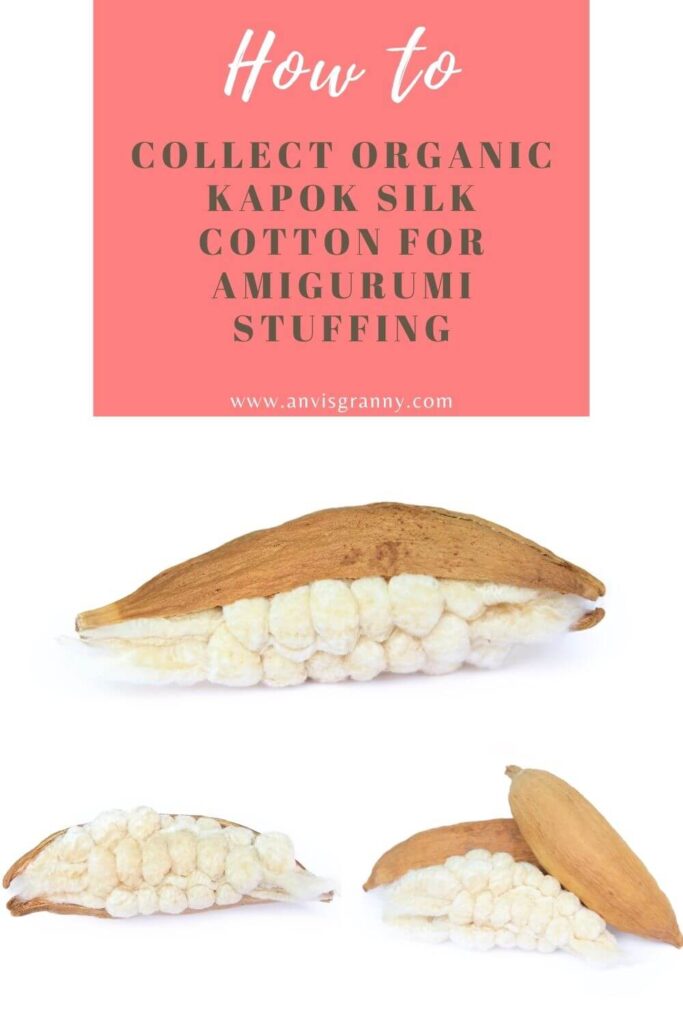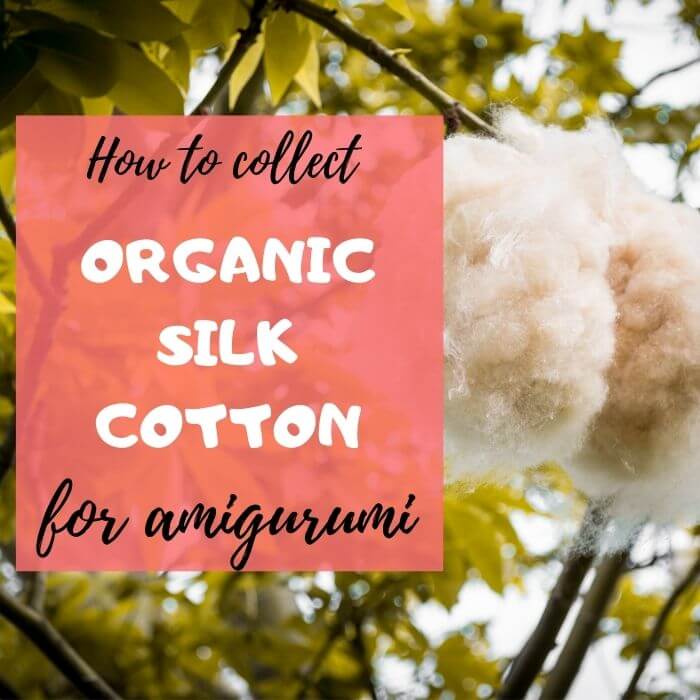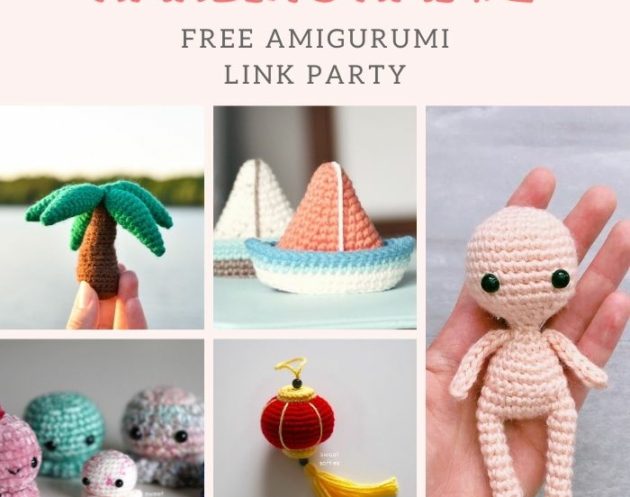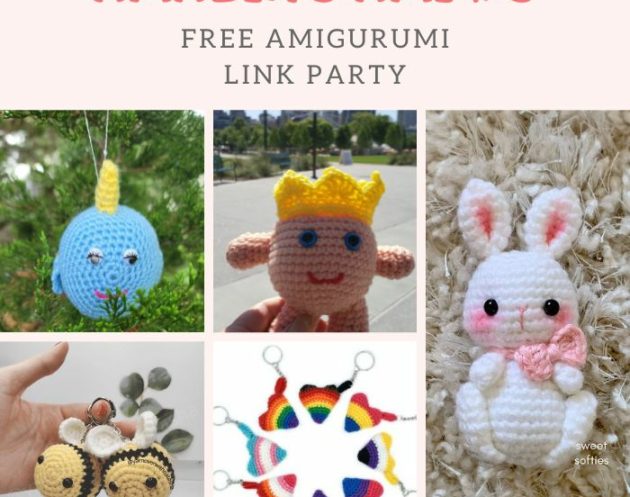Organic cotton is the great stuffing for pillows, amigurumi if you are a fan of sustainable products, and Kapok silk cotton is an alternate option for you. During this post, you will know about the Kapok tree, the benefits, and how to collect the organic silk cotton from the fruit, to use as stuffing. With such natural cotton that I collected from the garden, my dolls will be crocheted with organic cotton yarn and stuffed with the fuffy, soft-like-baby-cheek homemade Kapok cotton! If you have a Kapok tree around, let’s have fun harvesting the fruit and collecting the cotton for your crochet toys!
As you know, I am a Vietnamese living in India with my sweet little family. Every summer in Vietnam or at the beginning of the year in India, I could see so many Kapok trees blossoming, like the red clouds in the sky! In Vietnam, we call the tree “Cay Gao”, which means “rice tree”, and they are a typical part of Vietnamese villages. But it was the first time this year that I tried to collect the fruit and got the fibre from the Kapok pod, to stuff my beloved amigurumi.
IN HURRY? PLEASE SAVE THE POST TO READ LATER!

LATEST POSTS
- Cutest Crochet Christmas Light Pattern – No sew Amigurumi Ornament
- Free Crochet Poinsettia Pattern – No sew Christmas Ornament
- Free Crochet Christmas Pickle Pattern – No-sew Amigurumi Ornament
- Santa Crochet Pinecone Pattern Free – No sew Christmas Amigurumi Ornament
- Crochet Snowflake Amigurumi Ornament Free Pattern
In case you are new to amigurumi, check my Ultimate guide to amigurumi for beginners to learn how to crochet amigurumi and get tips from me.
Watch the video about how to collect the Kapok silk cotton from the pod here:
<iframe width=”560″ height=”315″ src=”https://www.youtube.com/embed/pspfKyczgkQ” title=”YouTube video player” frameborder=”0″ allow=”accelerometer; autoplay; clipboard-write; encrypted-media; gyroscope; picture-in-picture” allowfullscreen></iframe>
WHAT IS THE KAPOK TREE?
Kapok is also known as the Java cotton, Java kapok, silk-cotton or samauma. A tropical tree native to Mexico, Central America and the Caribbean, northern South America, and to tropical west Africa, Kapok Tree or Ceiba pentandra, is now a widely cultivated in Southeast Asia for its seed fibre. It is fast growing and reaches up to 70 m in height and 3 m in trunk diameter. The trunk is buttressed and large simple thorns, similar to that of on many of the larger branches, are found on it. The crown is thin and pagoda shaped. The leaves are palmate, with 5 to 9 leaflets each.
Kapok produces several pods that contain seeds covered by fibre. Kapok fibre is yellowish in colour, light, very buoyant, water resistant, resilient, but very flammable. It is used as stuffing in mattresses, pillows, etc. The seed of kapok yields oil that is used in making soap and as fertiliser. The seed is edible either raw or cooked (roasted and ground into powder).
Tender leaves, buds, and fruits are eaten like Abelmoscheus moschatus or okra. The flowers are blanched and eaten with chilli sauce; dried stamens are added to curries and soups. Bark decoction, on the other hand, is used as a diuretic, aphrodisiac, and as treatment for headache and diabetes. Kapok, in general, is used medicinally for fever, spasms, and bleeding. Different plant parts have a wide range of medicinal functions as well.
[mailerlite_form form_id=7]THE BENEFIT OF THE KAPOK FIBER
As Wikipedia, The Kapok fibre is light, very buoyant, resilient, resistant to water, but very flammable. The process of harvesting and separating the fibre is labor-intensive and menial. It is difficult to spin, but is used as an alternative to down as filling in mattresses, pillows, upholstery, zafus, and stuffed toys such as teddy bears, and for insulation. It was previously much used in life jackets and similar devices until synthetic materials largely replaced the fibre. The seeds produce an oil that is used locally in soap and can be used as fertilizer.
Using silk cotton from Kapok tree as amigurumi stuffing has some significant befenits that you might want to know (as dengarden.com)
- Non-Toxic and Chemical-Free: Kapok fibre does not need to be treated with chemicals to make it safe or healthy for use, as it is naturally healthy and safe. Thus, kapok is a 100% natural and organic fibre.
- Naturally Hypoallergenic: Kapok fib is naturally hypoallergenic, anti-microbial, and dust mite resistant. The kapok fibre naturally repels moisture, making it unsuitable for mold, mildew, and bacteria to thrive in.
- Durable and Washable: Kapok fibres are strong and can last for a long time. Every month or so, put the kapok pillow/amigurumi out in the sun. They can also be washed easily.
- Eco-Friendly: Kapok is one of the few sustainable rainforest products that is 100% organic and does not have adverse effects on the environment in its growing, production, and by its product.
Now I am sure that you want a Kapok silk cotton pillow or mattress in the house, but if you just have some fibre like me, amigurumi stuffing is an option! It will be a great organic gift for the newborn baby with organic cotton yarn and naturual stuffing.
WANT TO SAVE BEAUTIFUL NEW PINS INTO YOUR PINTEREST BOARD? YOU SHOULD PIN THOSE


HOW TO COLLECT KAPOK COTTON FOR AMIGURUMI STUFFING AT HOME?
- Collect the dry fruits from the tree. You can easily pick up the fruits that dropped onto the ground. Me and my kids collected them like that. By shaking the tree, a lot of well-dry fruits fall down.
- Prepare: A big bag for the fibre and a container for the seeds.
- Turn off your fan, or sit at the wind-block place, you don’t want to run after the fibre all the time.
- Wear your mask, because you might sneeze sometimes with the fibre in your nose! 🙂
- Open the pod, take small amount of the fibre, remove the seeds.
- Use the fibre to stuff your amigurumi! Yeahhh
Tada, done! Collecting enough fibre to stuff a mattress or pillows is not easy, but after just 30 mins and 15 fruits, I and my children could collect enough cotton to stuff a Zodiac Princess. Not too much, right? Actually it was a great summer activity for my kids when they were all at home! Have fun, and be useful, cool, isn’t it?
Oh, if you have a Kapok tree nearby, don’t hesitate, I am sure you would also have fun like us! Comment below and tell me if my post is useful for you!
And do not forget to subscribe to my newsletter, my Youtube Channel to be updated about new patterns or crochet tips, sales, and other promotions. Be my friend on Pinterest, Instagram, or Facebook. Any subs, like, comment from you means a lot for me and my small designing career!
From Joy with love!




